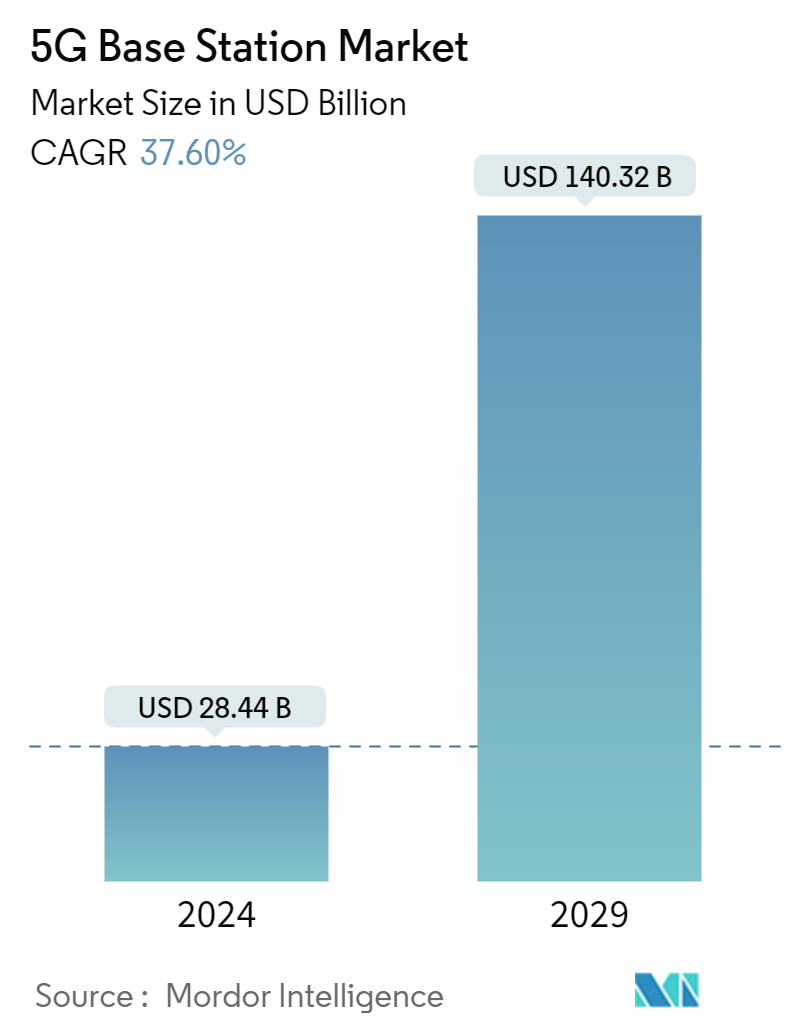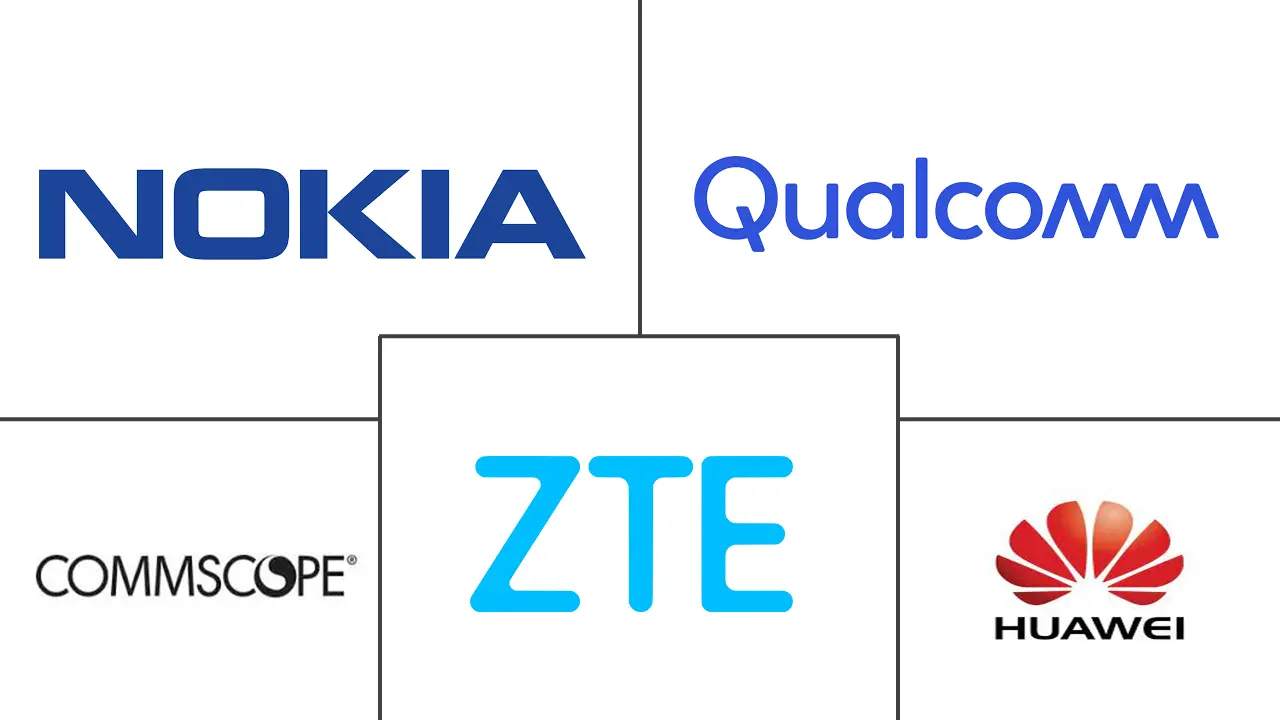Market Size of 5G Base Station Industry

| Study Period | 2019 - 2029 |
| Market Size (2024) | USD 28.44 Billion |
| Market Size (2029) | USD 140.32 Billion |
| CAGR (2024 - 2029) | 37.60 % |
| Fastest Growing Market | Asia Pacific |
| Largest Market | Asia Pacific |
Major Players
*Disclaimer: Major Players sorted in no particular order |
5G Base Station Market Analysis
The 5G Base Station Market size is estimated at USD 28.44 billion in 2024, and is expected to reach USD 140.32 billion by 2029, growing at a CAGR of 37.60% during the forecast period (2024-2029).
The 5G base station market has experienced significant growth in recent years because of the strong need for high-speed network connectivity. The smartphone ownership rate steadily rises each year in advanced and emerging economies. Utilizing advanced technologies such as AR and VR, brands can enhance their customers' shopping experience with the help of 5G networks, assisting them in finding the most suitable product for their requirements.
- 5G technology provides a much lower latency rate, which is the time it takes to receive and send information. Reducing overall latency enhances user satisfaction and opens up new possibilities for creative applications.
- Additionally, there is a movement toward ultra-reliable low latency communications (URLLC) within the 5G network design realm. This feature allows for optimal organization of data exchanges. It supports high-level services like factory automation, industrial internet, smart grid, autonomous driving, and robotic surgeries. Therefore, the increasing need for faster response times in the mentioned applications is greatly driving the expansion of the worldwide 5G base station industry.
- 5G technology can significantly enhance public safety and security in smart cities. Intelligent city networks can gather and examine vast quantities of information from different origins, such as video cameras, intelligent traffic lights, and other Internet of Things (IoT) devices, through the fast and effective 5G network.
- Additionally, IoT networks utilizing 5G technology would enable faster communication among interconnected devices due to 5G speeds reaching up to 1 Gbps. Therefore, IoT systems and devices linked to 5G will be extremely precise when performing time-sensitive tasks.
- The expenses for setting up the necessary 5G infrastructure and upgrading software are significantly high due to the large number of BTS units needed for continuous 5G service delivery. Successful implementation of the 5G network could necessitate significant upgrades in cell sites, connective nodes, central switches, software, and mobile devices.
5G Base Station Industry Segmentation
The 5G base station is a fixed communication equipment that connects using a single or several antennas. It includes a wireless receiver and a small-range transceiver with an antenna and analog-to-digital converters to transform radio frequency impulses into digital signals. The 5G base station primarily focuses on high-bandwidth and high-traffic-usage scenarios and real-time communications with high reliability and latency requirements.
The 5G base station market is segmented by type (small cell and macro cell), end user (commercial, residential, industrial, government, smart cities, and other end users), and geography (North America, Europe, Asia-Pacific, Middle East and Africa, and Latin America). The market sizes and forecasts are provided in terms of value (USD) for all the above segments.
| By Type | |
| Small Cell | |
| Macro Cell |
| By End User | |
| Commercial | |
| Residential | |
| Industrial | |
| Government | |
| Smart Cities | |
| Other End Users |
| By Geography*** | |
| North America | |
| Europe | |
| Asia | |
| Australia and New Zealand | |
| Latin America | |
| Middle East and Africa |
5G Base Station Market Size Summary
The 5G base station market is poised for substantial growth, driven by the increasing demand for high-speed network connectivity and the proliferation of smartphone ownership in both advanced and emerging economies. The technology's ability to provide lower latency rates enhances user satisfaction and facilitates innovative applications across various sectors. This includes ultra-reliable low latency communications (URLLC) that support advanced services such as factory automation, smart grids, and autonomous driving. The integration of 5G technology in smart cities further propels market expansion, as it enhances public safety and security through efficient data processing from IoT devices. Despite the high costs associated with establishing the necessary infrastructure, the demand for 5G base stations continues to rise, particularly in smart city applications where small cells play a crucial role in providing coverage and capacity.
The Asia-Pacific region is a key driver of growth in the global 5G base station market, supported by robust investments and government initiatives promoting rapid deployment. Countries like China, Japan, and South Korea are at the forefront, with significant adoption of IoT and Industry 4.0 technologies fueling demand for 5G infrastructure. The market is characterized by fragmentation, with major players such as Huawei, ZTE, and Nokia competing for market share. Strategic collaborations, like those between Dell Technologies and Nokia, as well as Ericsson and Telefonica, are enhancing capabilities in private wireless connectivity and cloud RAN evolution, respectively. These developments underscore the market's potential for expansion, as companies leverage partnerships to strengthen their positions and meet the growing demand for 5G base stations globally.
5G Base Station Market Size - Table of Contents
-
1. MARKET INSIGHTS
-
1.1 Market Overview
-
1.2 Industry Attractiveness - Porter's Five Forces Analysis
-
1.2.1 Bargaining Power of Suppliers
-
1.2.2 Bargaining Power of Buyers
-
1.2.3 Threat of New Entrants
-
1.2.4 Intensity of Competitive Rivalry
-
1.2.5 Threat of Substitute Products
-
-
-
2. MARKET SEGMENTATION
-
2.1 By Type
-
2.1.1 Small Cell
-
2.1.2 Macro Cell
-
-
2.2 By End User
-
2.2.1 Commercial
-
2.2.2 Residential
-
2.2.3 Industrial
-
2.2.4 Government
-
2.2.5 Smart Cities
-
2.2.6 Other End Users
-
-
2.3 By Geography***
-
2.3.1 North America
-
2.3.2 Europe
-
2.3.3 Asia
-
2.3.4 Australia and New Zealand
-
2.3.5 Latin America
-
2.3.6 Middle East and Africa
-
-
5G Base Station Market Size FAQs
How big is the 5G Base Station Market?
The 5G Base Station Market size is expected to reach USD 28.44 billion in 2024 and grow at a CAGR of 37.60% to reach USD 140.32 billion by 2029.
What is the current 5G Base Station Market size?
In 2024, the 5G Base Station Market size is expected to reach USD 28.44 billion.

